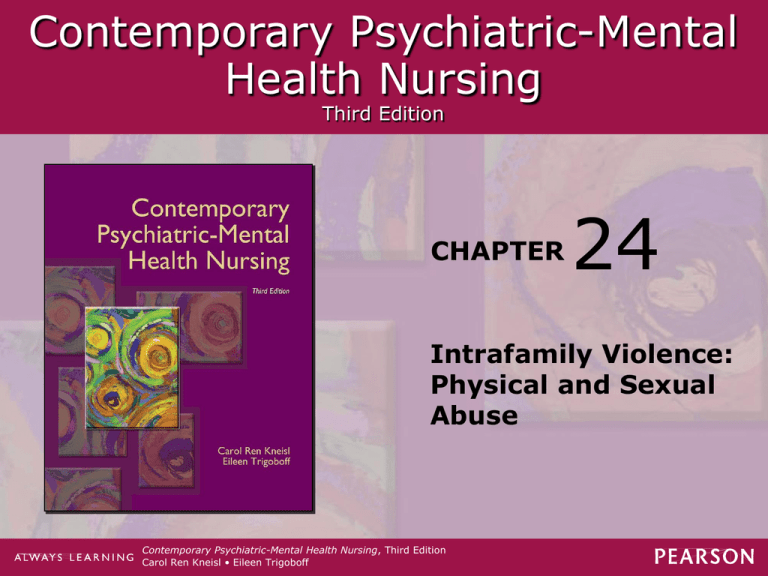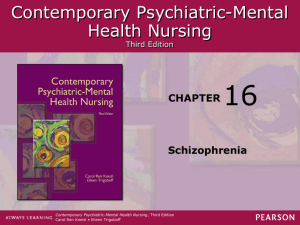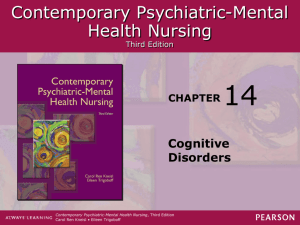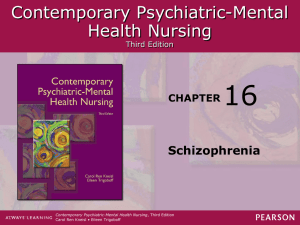
Contemporary Psychiatric-Mental
Health Nursing
Third Edition
CHAPTER
24
Intrafamily Violence:
Physical and Sexual
Abuse
Contemporary Psychiatric-Mental Health Nursing, Third Edition
Carol Ren Kneisl • Eileen Trigoboff
Contemporary Psychiatric-Mental Health Nursing, Third Edition
Carol Ren Kneisl • Eileen Trigoboff
• Family violence encompasses spouse
battering; neglect and physical,
emotional, or sexual abuse of children;
elder abuse; and marital rape.
• In many cases, family members tolerate
abusive and violent behavior from
relatives they would never accept from
strangers
Contemporary Psychiatric-Mental Health Nursing, Third Edition
Carol Ren Kneisl • Eileen Trigoboff
Contemporary Psychiatric-Mental Health Nursing, Third Edition
Carol Ren Kneisl • Eileen Trigoboff
Intimate partner violence
• is the mistreatment or misuse of one
person by another in the context of an
emotionally intimate relationship.
• The relationship may be spousal, between
partners, boyfriend, girlfriend, or an
estranged relationship.
• The abuse can be emotional or
psychological, physical, sexual, or a
combination (which is common).
Contemporary Psychiatric-Mental Health Nursing, Third Edition
Carol Ren Kneisl • Eileen Trigoboff
• Psychological abuse (emotional abuse)
includes name-calling, belittling, screaming,
yelling, destroying property, and making threats
as well as subtler forms, such as refusing to
speak to or ignoring the victim.
• Physical abuse ranges from shoving
and pushing to severe battering and choking and
may involve broken limbs and ribs, internal
bleeding, brain damage, and even homicide.
Sexual abuse includes assaults during sexual
relations such as biting nipples, pulling hair,
slapping and hitting, and rape
Contemporary Psychiatric-Mental Health Nursing, Third Edition
Carol Ren Kneisl • Eileen Trigoboff
Contemporary Psychiatric-Mental Health Nursing, Third Edition
Carol Ren Kneisl • Eileen Trigoboff
The cycle of violence or abuse
• is another reason often cited for why women
have difficulty leaving abusive relationships.
• A typical pattern exists: Usually, the initial
episode of battering or violence is followed by a
period of the abuser expressing regret,
apologizing, and promising it will never happen
again. He professes his love for his wife and may
even engage in romantic behavior (e.g., buying
gifts and flowers). This period of contrition or
remorse sometimes is called the honeymoon
period.
Contemporary Psychiatric-Mental Health Nursing, Third Edition
Carol Ren Kneisl • Eileen Trigoboff
• the tension-building phase begins; there
may be arguments, stony silence, or
complaints from the husband.
• The tension ends in another violent
episode after which the abuser once again
feels regret and remorse and promises to
change.
Contemporary Psychiatric-Mental Health Nursing, Third Edition
Carol Ren Kneisl • Eileen Trigoboff
Rape
• Is the perpetration of an act of sexual
intercourse with a female against her will
and without her consent, whether her will
is overcome by force, fear of force, drugs,
or intoxicants.
• It is also considered rape if the woman is
incapable of exercising rational judgment
because of mental deficiency or when she
is younger than the age of consent
Contemporary Psychiatric-Mental Health Nursing, Third Edition
Carol Ren Kneisl • Eileen Trigoboff
1. Rape may occur within a marriage and is
often accompanied by extreme violence.
The myth about male rape has been that
it occurs only in situations where
heterosexual contact is not possible, but
today more male rape victims are
reporting the crime.
Contemporary Psychiatric-Mental Health Nursing, Third Edition
Carol Ren Kneisl • Eileen Trigoboff
2. Victims of rape are women.
- Victims may be of any age, although one
in five victims is a teen.
- Half of rape victims know their abuser,
and half of rapes occurring on college
campuses are date rapes.
- Alcohol abuse is frequently a contributing
factor.
Contemporary Psychiatric-Mental Health Nursing, Third Edition
Carol Ren Kneisl • Eileen Trigoboff
3. Children are at risk of intrafamily violence
when they live with parents who were
abused as children, have adult
dysfunctional relationships, have poor
self-esteem, are socially isolated, have
unrealistic expectations of children’s
abilities, or if there are children with
special needs in the home.
Contemporary Psychiatric-Mental Health Nursing, Third Edition
Carol Ren Kneisl • Eileen Trigoboff
male rapists have four categories
• Sexual sadists who are aroused by the
pain of their victims
• Exploitive predators who impulsively use
their victims as objects for gratification
• Inadequate men who believe that no
woman would voluntarily have sexual
relations with them and who are obsessed
with fantasies about sex
• Men for whom rape is a displaced
expression of anger and rage.
Contemporary Psychiatric-Mental Health Nursing, Third Edition
Carol Ren Kneisl • Eileen Trigoboff
Rape
• is a crime of violence generated by issues
of power and control, rather than by sex
drive
•According to the intrapersonal theory,
perpetrators who feel powerless and unsure
of themselves abuse others to discharge
their anger and frustration.
• Intrapersonal theory categorizes five types
of rape: anger, power, sadistic, gang, and
date or acquaintance rapes
Contemporary Psychiatric-Mental Health Nursing, Third Edition
Carol Ren Kneisl • Eileen Trigoboff
Most rapists/convicted sex offenders are
young, do not suffer from major mental
disorders, and report having been
sexually and physically abused as
children or adolescents.
Contemporary Psychiatric-Mental Health Nursing, Third Edition
Carol Ren Kneisl • Eileen Trigoboff
The social learning theory focuses more on the
contribution of the media and culture in
desensitizing individuals to the pain, fear, and
humiliation of sexual aggression.
Gender bias theory considers rape as the result of
deeply rooted socioeconomic traditions; men are
viewed as dominant and women as subservient.
According to this theory, men see women as
wanting, needing, or deserving to be raped. As a
result, men believe that women do not experience
any physical or emotional harm by the rape
Contemporary Psychiatric-Mental Health Nursing, Third Edition
Carol Ren Kneisl • Eileen Trigoboff
Contemporary Psychiatric-Mental Health Nursing, Third Edition
Carol Ren Kneisl • Eileen Trigoboff
cause of domestic violence.
• According to the neurobiologic theory,
changes in genes and neurotransmitters are
believed to contribute to violent behaviors.
•The intrapersonal theory places emphasis
on the personality of the abuser, family
dynamics, and the inability of the individual
to control impulsive expressions of anger
- For instance, 80% of male abusers
experienced domestic violence while
growing up.
Contemporary Psychiatric-Mental Health Nursing, Third Edition
Carol Ren Kneisl • Eileen Trigoboff
• Social learning theory contends that
violence is a learned behavior, reinforced
when violence is rewarded by a gain in
power, and is a conscious choice made by
the abuser.
Gender bias theory suggests that men
have the right to keep women subordinate
by any means possible.
Contemporary Psychiatric-Mental Health Nursing, Third Edition
Carol Ren Kneisl • Eileen Trigoboff
Sexual abuse
- involves a combination of family,
personality, and cultural factors.
- Intrapersonal theory suggests that
perpetrators have low self-esteem; lack
impulse control; are rigid,
overcontrolling, dominant, and
aggressive; and some were emotionally
deprived as children.
Contemporary Psychiatric-Mental Health Nursing, Third Edition
Carol Ren Kneisl • Eileen Trigoboff
-A number were sexually abused as
children.
-Families that are enmeshed, have chaotic
boundaries, no assigned roles, and poor
communication patterns are at higher risk
for sexual abuse
Contemporary Psychiatric-Mental Health Nursing, Third Edition
Carol Ren Kneisl • Eileen Trigoboff
-Childhood victims may become offenders
when anger and hostility about the past are
externalized and projected onto new
victims.
-According to family systems theory,
intrafamily sexual abuse typically occurs in
families that have difficulty with structure,
cohesion, adaptability, and communication
Contemporary Psychiatric-Mental Health Nursing, Third Edition
Carol Ren Kneisl • Eileen Trigoboff
Learning Outcome 2
Discuss the short-term and long-term
effects on victims of intrafamily violence.
Contemporary Psychiatric-Mental Health Nursing, Third Edition
Carol Ren Kneisl • Eileen Trigoboff
The four phases of response to
rape
1- The anticipatory phase begins when the victim
realizes the situation is potentially dangerous.
2- The impact phase includes the period of actual
assault and its immediate aftermath.
3- In the reconstitution phase, the victim has the
outward appearance of adjustment but continues to
be anxious, fearful, and have feelings of
depression, guilt, shame, and vulnerability.
4- In the resolution phase, the victim may still be
angry, need to talk and seek support, but comes to
terms with the event
Contemporary Psychiatric-Mental Health Nursing, Third Edition
Carol Ren Kneisl • Eileen Trigoboff
Rape changes the victim’s life
forever
-Physical injuries resulting from rape,
-Psychological impact.
- Rape trauma syndrome: describes the
victim’s response, although people may
react in a variety of ways
Contemporary Psychiatric-Mental Health Nursing, Third Edition
Carol Ren Kneisl • Eileen Trigoboff
Factors that influence a victim’s
response
1. age, developmental state, victimization
history, resources, and the rape itself.
2. During the rape and during initial
treatment, victims may use
depersonalization or dissociation.
Anxiety, agitation, and nonpurposeful
behaviors may develop into shock,
disbelief, and fear
Contemporary Psychiatric-Mental Health Nursing, Third Edition
Carol Ren Kneisl • Eileen Trigoboff
Long-term consequences of Rape
trauma
• Posttrauma depression has a short-term
effect, and usually lasts up to 3 months.
• Major depressive disorder that will require
medical intervention.
• The reactions of some victims may
interfere with daily functioning and include
flashbacks, violent dreams, preoccupation
with thoughts of danger, social
withdrawal, phobic avoidance, and longterm sexual dysfunction.
Contemporary Psychiatric-Mental Health Nursing, Third Edition
Carol Ren Kneisl • Eileen Trigoboff
Other consequences
• Intense feelings of shame, guilt, and secrecy
keep them isolated, which leads to alienation
from peers.
• Other feelings include powerlessness, self-defeat,
and self-destruction.
• Some victims use denial to cope with the trauma,
others may act out sexually or run away from
home.
• When sexual abuse is severe or sadistic, victims
may develop dissociative identity disorder.
Contemporary Psychiatric-Mental Health Nursing, Third Edition
Carol Ren Kneisl • Eileen Trigoboff
• Intrafamily violence includes sibling
abuse, child abuse and neglect, shaken
baby syndrome, homicide of a child or
parent, partner abuse, abuse of elders and
pregnant women, and emotional abuse
Contemporary Psychiatric-Mental Health Nursing, Third Edition
Carol Ren Kneisl • Eileen Trigoboff
Treating victims of violence
-The first part of treatment is to ensure the
client’s safety and well-being.
- Attending to medical needs always takes
priority.
-Given the high risk for psychological
problems, it is recommended that a
comprehensive assessment be performed.
- Assessments should include physical,
behavioral, affective, cognitive, and
sociocultural components
Contemporary Psychiatric-Mental Health Nursing, Third Edition
Carol Ren Kneisl • Eileen Trigoboff
Interventions
1- Assuring safety;
2- developing rapport between the medical
professional and the victim;
3- identifying the victim’s strengths,
abilities, coping skills and support systems;
and suggesting therapy.
4- Building a sense of trust and rapport with
a victim of violence is crucial.
5- Talking about the trauma and expressing
feelings can be very painful.
Contemporary Psychiatric-Mental Health Nursing, Third Edition
Carol Ren Kneisl • Eileen Trigoboff
Intervention
-Many clients will need ongoing support,
community services, and long-term individual and
group counseling
-Identifying effective coping skills, strengths, and
abilities, and evaluating new coping strategies will
assist the client to progress from the state of victim
to one of survivor.
- Managing the individual’s case holistically versus
focusing on any one specific issue will bring better
results.
- Therapy is usually supportive and focuses on
restoring the victim’s lost sense of control
Contemporary Psychiatric-Mental Health Nursing, Third Edition
Carol Ren Kneisl • Eileen Trigoboff
Community-based interventions
1. identifying risk factors
2. implementing crisis interventions
Contemporary Psychiatric-Mental Health Nursing, Third Edition
Carol Ren Kneisl • Eileen Trigoboff
Continue …..inter
• Multidisciplinary approach: Medical, social, and
legal professionals must coordinate to intervene
effectively.
• Psychoeducation training can assist the client to
improve in the areas of communication, conflict
resolution, anger management, and parenting
skills.
• It is important to empower the victim to regain
control.
• Treating the abuser should also be a component.
Abusers need to learn that violence is always a
choice.
Contemporary Psychiatric-Mental Health Nursing, Third Edition
Carol Ren Kneisl • Eileen Trigoboff
Contemporary Psychiatric-Mental Health Nursing, Third Edition
Carol Ren Kneisl • Eileen Trigoboff
Contemporary Psychiatric-Mental Health Nursing, Third Edition
Carol Ren Kneisl • Eileen Trigoboff
The important of spiritual recovery for
persons who have been victims of violence
1- Survivors are frequently consumed with
spiritual questions and struggle with
questions of a God who either overlooked or
did not see their pain.
2- Survivors who become angry with God
and hold God responsible may become
fearful and feel guilty for hating someone so
powerful
Contemporary Psychiatric-Mental Health Nursing, Third Edition
Carol Ren Kneisl • Eileen Trigoboff
Continue…
1. Healing is a long process and survivors
need to experience human contact.
2. Spirituality includes a sense of
connectedness and allows the survivor to
develop trusting relationships.
3. When a survivor can self-forgive, more
complete healing is possible.
4. If clients desire, religious counselors who
understand the emotional issues involved
can assist them in working through their
struggles.
Contemporary Psychiatric-Mental Health Nursing, Third Edition
Carol Ren Kneisl • Eileen Trigoboff
Child abuse
Is defined as: The intentional injury of a
child.
It can include physical abuse or injuries,
neglect or failure to prevent harm, failure
to provide adequate physical or
emotional care or supervision,
abandonment, sexual assault or
intrusion, and overt torture or maiming
Contemporary Psychiatric-Mental Health Nursing, Third Edition
Carol Ren Kneisl • Eileen Trigoboff
Contemporary Psychiatric-Mental Health Nursing, Third Edition
Carol Ren Kneisl • Eileen Trigoboff
Elder abuse
- is the maltreatment of older adults by
family members or caregivers.
- It may include physical and sexual abuse,
psychological abuse, neglect, selfneglect, financial exploitation, and denial
of adequate medical treatment.
- Estimates are that people over age 65
are injured, exploited, abused, or
neglected by their caregivers and that
only 1 in 14 elder maltreatment cases are
reported
Contemporary Psychiatric-Mental Health Nursing, Third Edition
Carol Ren Kneisl • Eileen Trigoboff
Contemporary Psychiatric-Mental Health Nursing, Third Edition
Carol Ren Kneisl • Eileen Trigoboff
Contemporary Psychiatric-Mental Health Nursing, Third Edition
Carol Ren Kneisl • Eileen Trigoboff
Question
The nurse is working with a group of
perpetrators of family abuse who are
attending a counseling session mandated by
the court. The focus of therapy should be
on:
Contemporary Psychiatric-Mental Health Nursing, Third Edition
Carol Ren Kneisl • Eileen Trigoboff
Question
1. Teaching them appropriate ways to deal
with anger.
2. Ensuring that they don’t place
themselves in situations in which they
may be provoked by others.
3. Requesting that they bring their families
to the session to identify family areas
that need improvement.
4. Instructing them to identify situations
that trigger angry outbursts.
Contemporary Psychiatric-Mental Health Nursing, Third Edition
Carol Ren Kneisl • Eileen Trigoboff
Rationale
Answer #1 is correct. Effective anger
management is part of developing a
healthier way to deal with stress and
frustration and avoid resorting to abusive
behavior.
Applying level
Contemporary Psychiatric-Mental Health Nursing, Third Edition
Carol Ren Kneisl • Eileen Trigoboff
Question
The nurse is working with a college student
who has been abused by a popular, wellknown football player on the school’s team.
Which statement by the nurse to the mental
health team indicates a judgmental attitude
toward the student’s experience?
Contemporary Psychiatric-Mental Health Nursing, Third Edition
Carol Ren Kneisl • Eileen Trigoboff
Question
1. “Rape is an issue of power and control.”
2. “She probably realized he wasn’t
interested in a long-term relationship, so
she called it rape.”
3. “When alcohol is involved, a lot of bad
things can happen.”
4. “Parents should meet their children’s
dates before they go out.”
Contemporary Psychiatric-Mental Health Nursing, Third Edition
Carol Ren Kneisl • Eileen Trigoboff
Rationale
Answer #2 is correct. By believing the
student is claiming rape to get back at her
boyfriend, the nurse automatically assumes
that all women pursue men with resources
and status.
Creating level
Contemporary Psychiatric-Mental Health Nursing, Third Edition
Carol Ren Kneisl • Eileen Trigoboff
Question
The nurse herself was a victim of domestic
violence in the past. Which statement by the
nurse indicates that the nurse should not
work with a victim of abuse?
Contemporary Psychiatric-Mental Health Nursing, Third Edition
Carol Ren Kneisl • Eileen Trigoboff
Question
1. “I will make sure her husband is
punished for what he did to her.”
2. “I really feel bad for my client and angry
toward her husband.”
3. “I feel bad that she allowed things to get
this bad for her.”
4. “I will make sure my client understands
her rights and knows where to go for
help.”
Contemporary Psychiatric-Mental Health Nursing, Third Edition
Carol Ren Kneisl • Eileen Trigoboff
Rationale
Answer #1 is correct. Vowing to pursue
punishment of the husband shows that the
nurse is overinvolved in the client’s situation
and that the nurse’s primary focus is to
“punish” the abuser, whereas the focus
should be on attending to the client’s needs
and providing her with tools and resources
to protect herself.
Applying level
Contemporary Psychiatric-Mental Health Nursing, Third Edition
Carol Ren Kneisl • Eileen Trigoboff




